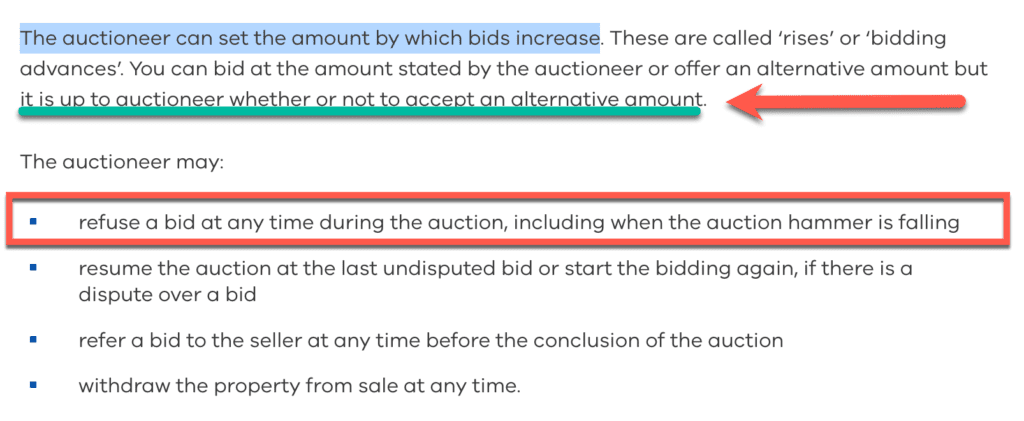On Wednesday night, I experienced one of the quirkiest auction experiences ever. I secured a property for two very dear clients, and with a mere one dollar bid. That certainly wasn’t my initial strategy, but like all auctions, we have to take stock of the situation, try to understand our opponent’s approach, and think quickly with every bid. Every auction is different and we often need to pivot our plan when a situation unfolds.

The result certainly prompted a lot of conversation following the sale, and highlighted one of the most important things for buyers to understand.
The auction rules and the right of the auctioneer.
Rewind to Wednesday afternoon; we had the zoom auction link from the Ray White team, and the in-room auction campaign meant that our property of interest was being sold in succession, being number two of five auctions for the evening. We had registered our interest, arranged the small (refundable) holding deposit payment into the agency trust account, and had our paddle number assigned…. Lucky number eight. I had checked in a few times with the listing agent and his team to understand the likely flow of the night and the potential competition level. I knew we had competition.
The in-room auction experience was really interesting. I found out afterwards that the agency sold five out of five that night, and listing agent, Peter Travlos shared with me the rationale behind this style of auction. A feeling of heightened buyer competition, and in particular, their auction-order strategy can lead to positive vendor/buyer outcomes as they manage underbidders and subsequent opportunity.
The excitement and sense of keen buyer interest was obvious, with nearly fifty people logged in when the 6pm start time struck.
The first auction came and went, and our turn arrived. I kicked off the bidding at the base of the range and sparred with a phone bidder in $5,000 and $2,500 increments until we reached reserve. From this point a new bidder offered a bid of $118 via text in the chat box on zoom.

The murmurings at the auctioneer’s and agent’s end were audible and the bidder hastily sent a follow up message suggesting that the auctioneer couldn’t reject a higher bid. It was an interesting power play, and one that I knew could be to this bidder’s detriment if they weren’t familiar with the legislated auction rules.

An auctioneer, in fact can reject any bid and they do reserve the right to set the bidding increments.
I waited it out to see what the next step would be.
The auctioneer had an audience of some 45 people at this stage, many of whom would have been patiently sitting it out in anticipation for the auctions that followed. Some were wondering if allowing a small increment was permitted, others were audibly anxious about how long they’d have to wait for their property of interest to go to auction.
The auctioneer came back swiftly and announced that, at this stage, the vendor’s instruction was to accept all bids. And with that, I rounded the bid to the nearest $500, adding $382 to the current bid.
But my challenger came back with one dollar.
I mixed up some low-level bidding increments, but it was abundantly clear that my challenger’s strategy was based on trying to fatigue me. The challenger sent a chat box message, naming me and advising that they had all night. I was on audio/video so I took the opportunity to smile and say that I, too had all night. The auctioneer tolerated us bidding in one dollar increments for a period of time, but the annoyance of other participants was palpable, and I knew that at some stage the auctioneer would revert to the vendors and recommend a minimum bidding increment. We couldn’t go on for hours with one dollar bids; it was non-sensical.
My strategy hinged on my challenger’s misunderstanding of the auction rules. The auctioneer took yet another break from the bidding and referred again with his vendors. At this stage the vendors supported an instruction for $500 minimum bidding increments and our auctioneer came back to the online auction portal to carefully remind all bidders that they would not be accepting any bids less than five hundred dollars. All I could hope for was that my challenger resisted the auctioneer’s instruction to increase the bidding increment.
And that they did.
Their text dialogue on the chat box suggested that they didn’t believe an auctioneer could reject a better bid. My adrenaline was running and I was prepped and ready to jump back in with higher increments, but as the third and final auction call rolled, it looked as though the challenger was sticking with their tiny-increment strategy.
The hammer fell and our beautiful duo, who had been sitting through what could only be described as a crazy auction experience were in shock, and so very thrilled with their acquisition.
They had fallen in love with the property at first sight.

The lofty raked ceilings, the abundance of light, and in particular the quiet neighbourhood at this sleepy little no-through-road end of the street ticked every box on their wish list.

Their desire for a spacious garage to incorporate car accommodation and a gym had been met with this incredible four-car space.

What this auction proved was to our advantage, but it’s a critical aspect that bidders must never forget.
The auctioneer determines the bids and can reject any bid.

Thanks to the team at Ray White Taylors Lakes
for supporting me to write about this auction,
and huge congratulations to our beautiful buyers.
REGISTER TO OUR NEWSLETTER
INFORMATION
CONTACT US
1A/58 ANDERSON STREET,
YARRAVILLE VIC 3013
0422 638 362
03 7000 6026
CATE@CATEBAKOS.COM.AU
